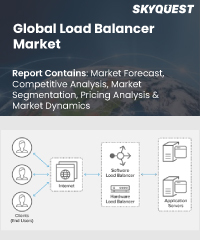
Report ID: SQMIG45A2182

Report ID:
SQMIG45A2182 |
Region:
Global |
Published Date: February, 2024
Pages:
157
|
Tables:
172 |
Figures:
79
Load Balancer Market size was valued at around 4.2 billion in 2022 and is expected to rise from USD 4.9 billion in 2023 to reach a value of USD 13.5 billion by 2031, at a CAGR of 13.6% over the forecast period (2024–2031).
The market's electrical power growth can be assigned to a number of factors, including an increase in the use of cloud load balancing services, increased business awareness of the advantages of networking and cloud technologies, the adoption of connected devices, and remote working practices.
This collaboration aims to develop integrations between Red Hat Openshift Container System, Red Hat Ansible Automation Platform, and F5 technologies. The collaboration assures that organizations shift to cloud-native operations and opens the door for non-traditional consumers of F5 services.
The increase in internet traffic can have an impact on server performance, but load-balancing gives the group the option to deploy more servers to accommodate the growing volume of incoming requests. Instead of migrating to a brand-new environment as necessary, customers can add more load balancers. Additionally, the server's configuration can be modified according to the needs of the company and the site's traffic.
For instance, during a sales season, a retail website can see considerable traffic; in this scenario, installing extra load-balanced internet servers will help lower latency. Other back-end servers will assume responsibility for ensuring traffic that comes in and maintaining the services if one server stops responding.
The interconnection of Internet of Things (IoT) devices requires robust request processing capabilities, which has led to widespread use of load balancers. The multi-access computing edge revolution and various firms' global sensor deployment programmes are driving growth in the load balancer market. For instance, Amazon Web Services introduced the Gateway Load Balancer, which scales and controls virtual appliances from third parties such as firewalls, intrusion detection and prevention systems, and advanced packet inspection devices in the cloud.
The ongoing deployment of IoT networks & the resulting rise in IoT traffic are both encouraging signs for the market's expansion. The aggressive implementation of the Bring Your Own Device (BYOD) policy by numerous organizations is also anticipated to increase the uptake of load-balancing systems. Load-balancing solutions are being implemented into business contexts through technologies like Azure Application Gateway, which offers improved and organized accessibility for communication at the security and network layers. Due to the rise in cyberattacks, including malware, phishing, along Denial of Service (DoS) attacks that target corporate networks, load balancing services are also essential.
The expansion of the market is anticipated to be constrained during the projected period by cyberattacks and the high cost of load-balancing network solutions. Many nations, including China, are taking action to stop data breaches. In January 2022, the China Cyberspace Administration (CAC) published a draft regulation on networking data security management.
Our industry expert will work with you to provide you with customized data in a short amount of time.
REQUEST FREE CUSTOMIZATIONLoad Balancer Market size was valued at USD 4.82 billion in 2021 and is poised to grow from USD 5.33 billion in 2022 to USD 16.14 billion by 2030, growing at a CAGR of 14.8% in the forecast period (2023-2030).
Players in the market are deemed to spend money on R&D projects to advance their internal business processes and assist growth. Companies are often observed participating in mergers, acquisitions, and joint ventures to improve their products and acquire a competitive edge in the market. In order to attract new clients and increase market share, they are actively working on the development of new items and the improvement of existing ones. 'F5 Networks, Inc.', 'Citrix Systems, Inc.', 'A10 Networks, Inc.', 'Radware Ltd.', 'Kemp Technologies, Inc.', 'Fortinet, Inc.', 'NGINX (acquired by F5 Networks)', 'Cisco Systems, Inc.', 'Barracuda Networks, Inc.', 'HAProxy Technologies SARL', 'Avi Networks (acquired by VMware)', 'Brocade Communications Systems, Inc.', 'Array Networks, Inc.', 'JetNexus Solutions Ltd.', 'Loadbalancer.org Ltd.', 'Pulse Secure, LLC (formerly known as Brocade vADC)', 'Snapt Inc.', 'Sangfor Technologies, Inc.', 'Incapsula Inc. (acquired by Imperva)', 'Hystrix Medical (acquired by Radware)'
With the growth of digitalization and the increasing reliance on online services, there is a growing demand for high-performance applications that can handle heavy traffic and deliver a seamless user experience. Load balancers play a crucial role in distributing incoming network traffic across multiple servers or resources, ensuring optimal performance and scalability.
Growing Adoption of Cloud-Based Load Balancers: Organizations are increasingly shifting their infrastructure to the cloud, leading to a higher demand for cloud-based load balancers. Cloud load balancers offer scalability, flexibility, and efficient resource utilization, making them a popular choice for managing traffic and optimizing application performance in cloud environments.
The North American market for load balancers led the world market with a 33.4% share. The development of cloud computing services began in North America, where every sphere of the local economy has embraced cloud-based solutions. Load balancers are being incorporated by many companies into their infrastructure systems in order to maintain performance and flexibility, which is expected to spur market growth.
Want to customize this report? This report can be personalized according to your needs. Our analysts and industry experts will work directly with you to understand your requirements and provide you with customized data in a short amount of time. We offer $1000 worth of FREE customization at the time of purchase.

Report ID: SQMIG45A2182